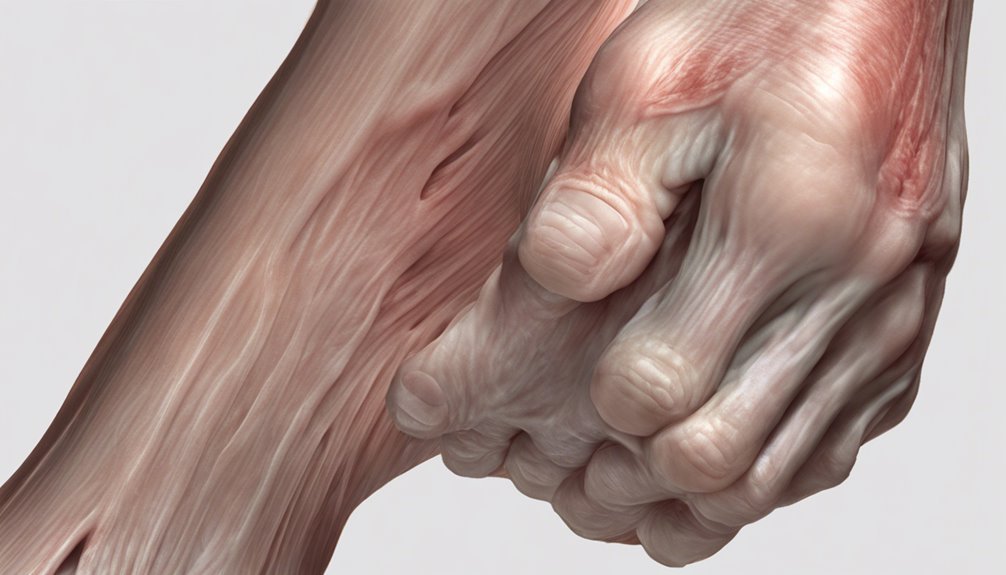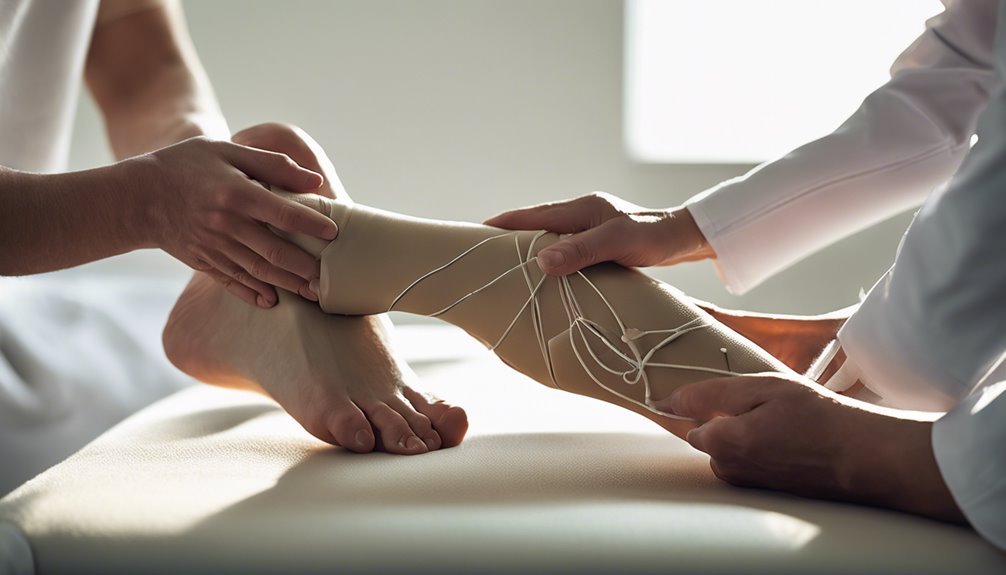You wake up with a persistent ache in your ankle, yet there’s no memory of a twist or fall. It’s a puzzle that many face, where ankle pain emerges without any apparent injury. Could it be arthritis, tendinitis, or maybe even an issue with your arches? Understanding these possibilities is vital, especially when everyday activities become a challenge. But how do you pinpoint the cause and, more importantly, find relief? Before jumping to conclusions, consider what underlying factors might be at play and how you can address them effectively. Curious about your next steps? There’s more to uncover.
Key Takeaways
- Arthritis and tendonitis are common causes of non-injury-related ankle pain due to inflammation.
- Biomechanical issues from flat feet or high arches can lead to uneven weight distribution and ankle discomfort.
- Weather changes can exacerbate joint pain, impacting individuals with arthritis or sensitive joints.
- Supportive footwear and lifestyle adjustments can alleviate biomechanical strain, which causes ankle pain.
- Persistent or severe ankle pain without injury warrants medical evaluation to identify underlying conditions.
Understanding Ankle Pain

Understanding ankle pain can be vital, especially when there’s no apparent injury. You might experience this discomfort due to various underlying conditions.
Arthritis, such as rheumatoid arthritis or osteoarthritis, often causes chronic ankle pain. These conditions lead to inflammation in the joint, resulting in swelling, stiffness, and reduced mobility. This can make even simple movements challenging.
Tendinitis is another culprit, typically arising from overuse of the ankle. You might notice pain and swelling around the ankle if you’ve been active, especially if the Achilles or tibialis anterior tendons are affected. This inflammation can disrupt your daily activities and requires attention to prevent further damage.
Biomechanics play an important role in how your ankles bear weight. Irregular foot arches can lead to uneven weight distribution. This imbalance strains your ankle, contributing to ongoing pain. Proper footwear and supportive insoles can help manage this issue.
Gout adds another layer of complexity. Characterized by the sudden buildup of uric acid crystals, it causes intense joint pain without warning. This can greatly impair your ankle’s function and lead to swelling.
Understanding these factors helps you manage ankle pain effectively and maintain your mobility.
Non-Injury Causes
When you experience ankle pain without a clear injury, it can be perplexing. You might wonder why your ankle hurts when you haven’t twisted it or taken a fall.
Non-injury causes often involve arthritis and tendonitis, leading to inflammation and discomfort. Arthritis, including rheumatoid arthritis and osteoarthritis, is a common culprit. These conditions cause joint inflammation and cartilage degeneration, resulting in chronic ankle pain.
Tendonitis, particularly Achilles tendonitis, is another frequent cause. This condition involves Achilles tendon inflammation, usually due to overuse or repetitive strain rather than a distinct injury.
If you have flat feet or high arches, you may notice uneven weight distribution, which strains your ankle and contributes to discomfort over time.
Interestingly, even weather changes can affect your joints. Some people are sensitive to barometric pressure, leading to increased joint pain and discomfort in the ankle without any prior injury.
Related Symptoms

Ankle pain’s accompanying symptoms often provide clues to its underlying cause. You might notice swelling, which is a telltale sign of inflammation and could be linked to arthritis or bursitis. Stiffness, particularly in the morning or after sitting for a while, often hints at conditions like rheumatoid arthritis. Tenderness around the joint, especially when pressed, might suggest tendonitis or bursitis. Redness and heat in the area can indicate inflammation or even an infection, especially if they persist. These symptoms can make walking difficult, affecting overall mobility and daily routines.
Here’s a quick overview of related symptoms and what they might indicate:
| Symptom | Possible Cause | Impact on Mobility |
|---|---|---|
| Swelling | Inflammation/Arthritis | Limited mobility |
| Stiffness | Arthritis | Difficulty walking |
| Tenderness | Tendonitis/Bursitis | Pain with movement |
If you experience difficulty walking or bearing weight due to pain or instability, these symptoms shouldn’t be ignored. They affect mobility and can also indicate underlying issues that require attention. Understanding these related symptoms helps you better assess the situation and decide if a medical evaluation is necessary.
Diagnosis Methods
To diagnose ankle pain without an obvious injury, start with a thorough physical examination that checks for swelling, range of motion, and tenderness.
You might also need imaging tests like X-rays or MRIs to uncover hidden issues such as arthritis or tendonitis.
Blood tests can reveal conditions like rheumatoid arthritis, providing a clearer picture of what might be causing the pain.
Physical Examination Techniques
Identifying the root cause of ankle pain without a clear injury involves a thorough physical examination.
First, your clinician will evaluate for swelling and tenderness around the ankle joint to understand the underlying issue. Checking the range of motion is critical to gauge any limitations contributing to your discomfort. Tests for instability, such as the anterior drawer test, can reveal ligament laxity, which could indicate conditions like arthritis.
Observing your gait and functional movements helps identify compensatory patterns. These patterns might suggest how your body is adjusting to avoid pain, which can be essential for determining the source of your ankle pain.
Palpating the ankle joint and the surrounding soft tissue structures allows the clinician to pinpoint specific areas of tenderness. This step is fundamental for differentiating between soft tissue and joint-related issues.
Additionally, evaluating nerve function and blood circulation in the foot can rule out conditions like tarsal tunnel syndrome.
These steps guarantee a thorough understanding of your ankle pain, providing a foundation for effective treatment. A detailed physical examination is imperative to address your ankle pain and restore mobility.
Imaging and Scans
Leveraging imaging and scans becomes essential when diagnosing ankle pain without an apparent injury. Imaging tests like X-rays are your first step. They help you identify fractures, bone spurs, or arthritis signs. If X-rays don’t reveal the cause, an MRI might be next. MRIs provide detailed images of soft tissues, such as ligaments and tendons, and can detect tendonitis or tears you might not see otherwise.
A CT scan is sometimes necessary to examine complex fractures or joint abnormalities in depth. Ultrasound imaging is invaluable for visualizing soft tissue structures in real-time. It can show fluid accumulation or inflammation, helping to diagnose conditions like bursitis.
Joint aspiration is another diagnostic tool. Removing fluid from the ankle joint allows you to analyze it for infections or crystals, which may indicate gout. This method helps confirm inflammation sources when other imaging tests leave questions unanswered.
Here’s a quick look at the emotional journey you might experience:
| Imaging Test | Emotion | Reason |
|---|---|---|
| X-rays | Curiosity | Initial exploration |
| MRI | Hope | Detailed soft tissue insights |
| Ultrasound Imaging | Relief | Real-time confirmation |
Blood Test Indicators
Blood tests offer essential insights into the underlying conditions contributing to ankle pain when there’s no obvious injury. These tests can help diagnose issues like rheumatoid arthritis and gout by measuring specific markers such as rheumatoid factor and uric acid levels. Elevated uric acid levels often point toward gout, a common source of joint discomfort.
Inflammation is another critical aspect that blood tests can uncover. High C-reactive protein (CRP) levels and erythrocyte sedimentation rate (ESR) suggest inflammation, which might be linked to conditions like tendinitis or bursitis affecting your ankle. These markers guide your doctor in pinpointing the cause of your pain.
A thorough blood count (CBC) can reveal infections or anemia exacerbating ankle pain. Infections mightn’t directly impact the ankle but can worsen symptoms, while anemia can cause fatigue that complicates recovery.
An antinuclear antibody (ANA) test could be beneficial in ruling out autoimmune disorders such as lupus, which might cause joint pain. Additionally, joint aspiration, which involves analyzing synovial fluid, can detect crystals or infections, providing further insight.
Combining these blood tests with joint aspiration guarantees a detailed understanding of your ankle pain.
Treatment Options

Non-surgical interventions, such as RICE and physical therapy, can effectively treat ankle pain without injury.
For managing pain and inflammation, consider using over-the-counter NSAIDs.
Additionally, supportive footwear or orthotics can correct alignment issues, easing discomfort and providing essential relief.
Non-Surgical Interventions
Several effective non-surgical interventions can help manage ankle pain without injury, offering relief and promoting healing. The RICE method—Rest, Ice, Compression, and Elevation—can reduce swelling and promote healing. Over-the-counter non-steroidal anti-inflammatory drugs (NSAIDs) like ibuprofen or naproxen are effective for alleviating pain and reducing inflammation. Physical therapy focuses on exercises and stretches to improve strength, flexibility, and stability in your ankle. Additionally, supportive footwear and orthotic inserts are essential for stability and alignment, especially if you have conditions like flat feet or arthritis.
| Intervention | Purpose |
|---|---|
| RICE Method | Reduce swelling and promote healing |
| NSAIDs | Alleviate pain and reduce inflammation |
| Physical Therapy | Enhance strength, flexibility, and stability |
| Supportive Footwear | Provide stability and proper alignment |
| Orthotic Inserts | Improve comfort and minimize discomfort |
At-home remedies, such as Epsom salt soaks, can promote relaxation and decrease inflammation. With their anti-inflammatory properties, turmeric supplements may also help manage ankle pain. These interventions, tailored to your specific needs, can effectively manage your symptoms and improve your quality of life without the need for surgery.
Pain Management Strategies
Many effective pain management strategies exist for addressing ankle pain without an injury. Start with the RICE method, which stands for Rest, Ice, Compression, and Elevation. This approach offers immediate relief and helps reduce inflammation.
For additional pain management, think about using NSAIDs like ibuprofen or aspirin. These medications effectively alleviate pain and swelling, especially if your discomfort stems from arthritis or tendinitis.
Physical therapy plays an important role in managing ankle pain. You’ll improve your ankle’s strength and flexibility through targeted exercises, helping reduce pain and prevent future issues. A physical therapist can guide you in implementing a personalized exercise plan that meets your needs.
Custom orthotics are another option. They can enhance ankle alignment and reduce stress, especially if you have flat feet or high arches. While exploring custom orthotics, supportive footwear choices can significantly improve pain management.
If you experience persistent or severe pain, corticosteroid injections might be an option. They provide targeted relief from inflammation in the affected joint or tendon, helping you manage your symptoms more effectively.
Supportive Footwear Benefits
Step into comfort and relief with supportive footwear, an essential treatment option for reducing ankle pain. Proper arch support and alignment in your shoes help distribute body weight evenly, minimizing stress on the ankle joint. This reduces discomfort and prevents further issues associated with arthritis or tendinitis.
By ensuring your footwear includes adequate cushioning, you can absorb impact during daily activities, reducing strain on your ankles.
Footwear design plays an important role in pain management. Shoes with a wider toe box allow for natural foot movement and reduce pressure on the ankle. This is particularly beneficial for people with flat feet or high arches.
Additionally, shoes with adjustable features, such as laces or straps, offer a customized fit that enhances stability and support. This reduces the likelihood of ankle instability and subsequent pain.
Research shows that individuals wearing supportive shoes report a 30% decrease in ankle pain symptoms compared to those wearing unsupportive footwear. This highlights the importance of selecting the right shoes to reduce pain.
Home Remedies
Ankle pain without injury can often be managed effectively at home with simple remedies.
Start with an Epsom Salt Soak. Soaking your ankle in warm water mixed with Epsom salt can relieve pain significantly. The magnesium in the salt helps relax muscles and reduce inflammation, easing ankle pain and swelling.
Next, incorporate Gentle Stretching exercises into your routine. Stretching enhances flexibility and decreases stiffness, which is especially beneficial when dealing with arthritis or tendinitis.
Adding Turmeric to your meals or taking it as a supplement can also help. Its active compound, curcumin, is known for its anti-inflammatory properties, which can reduce ankle inflammation.
Don’t overlook the importance of Hydration, either. Staying well-hydrated supports joint health and helps minimize inflammation and pain.
Finally, invest in Supportive Footwear. Shoes with good arch support and cushioning can significantly reduce pressure on your ankle, preventing discomfort during daily activities.
Seeking Medical Help

If your ankle pain persists without a clear injury, it’s important to seek medical help promptly. Persistent ankle pain shouldn’t be ignored, especially if it lasts more than a few days or worsens. Consulting a healthcare provider can help diagnose the cause and initiate appropriate treatment.
It’s vital to seek medical attention when experiencing:
- Significant swelling, redness, warmth, or fever: These symptoms may indicate an infection or serious underlying condition requiring urgent evaluation.
- Inability to bear weight or move the ankle without pain: Immediate evaluation can prevent complications and guarantee proper treatment.
- A history of underlying health conditions: Conditions like diabetes or autoimmune diseases necessitate prompt attention to prevent complications or symptom exacerbation.
- Chronic conditions like arthritis: Regular check-ups with a healthcare provider can help manage symptoms and prevent further joint damage.
Ignoring symptoms or delaying medical consultation could worsen conditions. By consulting a healthcare professional, you can identify any underlying health conditions contributing to the pain and take steps to prevent complications.
Your healthcare provider will guide you through appropriate tests and treatments, confirming you address the root cause of your persistent ankle pain.
Frequently Asked Questions
What Can Cause Sudden Ankle Pain Without Injury?
You might experience sudden ankle pain due to various factors like arthritis types, gout symptoms, tendonitis triggers, nerve issues, or muscle imbalances. Consider age factors, ankle swelling causes, blood circulation problems, and inappropriate footwear impact.
Why Is My Ankle Suddenly Aching Pain?
Your ankle’s sudden aching pain could be caused by joint inflammation or tendon strain. Consider ankle stability, footwear impact, or age factors. Overuse syndrome, stress fractures, circulation issues, arthritis symptoms, or weather changes might also contribute.
When Should I Be Worried About Ankle Pain?
You should worry about ankle pain if chronic conditions, inflammation issues, joint instability, or age factors are involved. Consider footwear choices, weight impact, and activity level. Underlying diseases or lifestyle changes might require a medical evaluation.
How Do You Treat Ankle Ligament Pain?
Rest, apply ice, and use compression bandages to treat ankle ligament pain. Incorporate stretching exercises, strengthening routines, and ankle support. Explore topical treatments and alternative therapies. Consult a medical professional for tailored physical therapy and additional guidance.
Conclusion
If you’re experiencing ankle pain without an obvious injury, don’t ignore it. Understanding the potential causes, like arthritis or tendinitis, helps you take proactive steps. Pay attention to symptoms such as swelling and stiffness. Consider supportive footwear and home remedies, but consult a healthcare professional if the pain persists. They’ll help diagnose and tailor a treatment plan for you. Taking action now can prevent further complications and improve mobility and quality of life.
